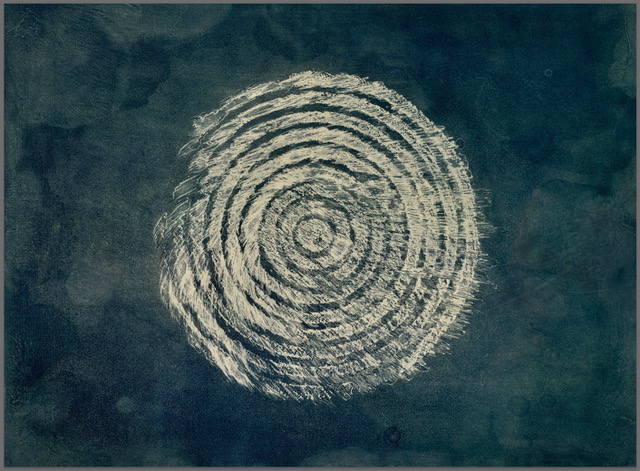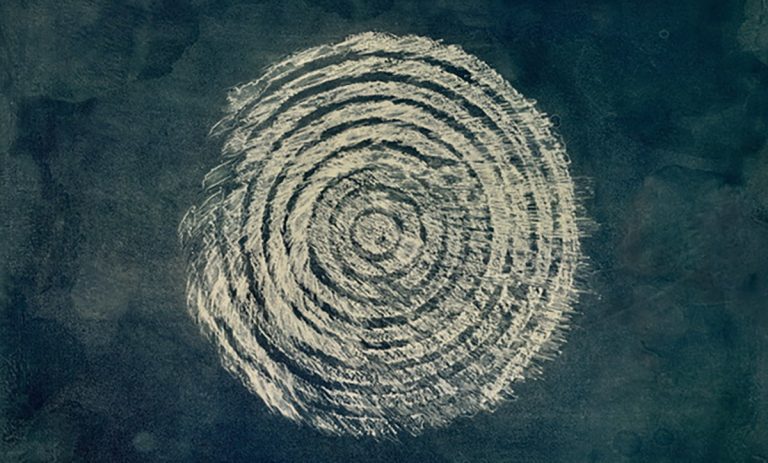Andrea Merciar’s “C. Circles Wheel” is a steel-plate etching that embodies her fascination with layering, texture, and the unexpected intersections of art and the everyday. Measuring 50 x 70 cm, the piece started with a simple act—rubbing a lithographic crayon over a manhole cover. That everyday imprint became the foundation for something deeper, something Merciar could push through the controlled chaos of intaglio printmaking.
For Merciar, intaglio is as close to drawing as printmaking allows. The process demands patience, control, and an intuitive understanding of materials. Steel, in particular, behaves differently from copper or zinc. It resists, takes longer to bite in acid, and yet, when done right, rewards the artist with rich, velvety marks that mimic the softness of aquatint. “I love creating watercolour washes within the monochrome,” she explains. There’s a certain contradiction in that—a material known for its permanence being manipulated to mimic the fluidity of paint.
A Study in Circles and Textures

“C. Circles Wheel” isn’t just about the manhole cover’s imprint; it’s about transformation. Merciar transferred the rubbing onto steel, then worked over it with paintbrushes, allowing her to deepen the contrast and refine the composition. The circular pattern takes center stage, layered with marks that suggest motion—perhaps the echoes of a wheel turning, time passing, or urban life quietly imprinting itself onto surfaces we rarely notice.
The circular motif isn’t new to Merciar’s work. She’s long been drawn to geometric forms, particularly those that suggest movement or containment. In this piece, the circle becomes a point of meditation. There’s symmetry, yet within it, the organic marks of her hand soften the industrial nature of the subject.
Steel and the Softness of Monochrome
Steel as a surface for etching is less common than copper or zinc, but Merciar embraces its qualities. “Etching steel gives a velvety quality, like a faux aquatint,” she says. Unlike traditional aquatint, which relies on resin and acid to create tonal variations, steel has an inherent graininess when etched. This texture, combined with her brush-applied touches, creates a layered effect that feels almost photographic in its depth.
Merciar’s love for monochrome isn’t about simplicity. It’s about focus. Without the distraction of color, the viewer is drawn into the textures, the subtle shifts in light and shadow, the way different depths of etching catch ink and define form. There’s a balance of control and spontaneity in her process—etching, by nature, involves an element of unpredictability. The acid can bite deeper than intended, ink can pool in unexpected ways. These moments, rather than being flaws, become part of the work’s character.
Between Urban Impressions and Printmaking Traditions
Merciar’s use of an urban surface—a manhole cover—as a starting point speaks to her interest in overlooked textures. Cities are layered places, full of marks left by time, weather, and movement. By rubbing the crayon over the metal cover, she captured a fleeting impression of something permanent. Then, through etching, she made it her own.
This dialogue between tradition and modernity runs throughout her work. Printmaking is one of the oldest forms of image-making, yet Merciar’s approach feels contemporary, even experimental. Her background in both fine art and digital media means she isn’t confined to one method of working. While she respects the tactile history of intaglio, she also pushes it forward, finding new ways to manipulate surfaces and ink to suit her vision.
The Physicality of Printmaking
There’s a physicality to Merciar’s process that comes through in the final work. The etched steel plate isn’t just a tool; it holds the history of every mark, every decision. The act of inking, wiping, and pressing the image onto paper requires effort, precision, and patience. Unlike digital media, where changes can be made instantly, intaglio demands commitment. Each layer, each etched line, is a decision that can’t be undone.
In “C. Circles Wheel,” that sense of commitment is evident. The work is intricate without being fussy, textured without being overwhelming. It invites the viewer to look closely, to trace the layers, to find the balance between the structured imprint of the manhole cover and the fluidity of Merciar’s brushwork.
A Dialogue Between Control and Chance
Perhaps the most compelling aspect of “C. Circles Wheel” is the tension between control and chance. The initial rubbing was an act of spontaneity—an imprint taken from the world. The etching process, by contrast, required careful manipulation. And yet, within that control, there’s always the unpredictable nature of acid, ink, and paper.
Merciar thrives in that space. She isn’t trying to make perfect, mechanical prints. She embraces the imperfections, the slight shifts in tone, the textures that emerge naturally. “For me, intaglio printmaking is the closest I can get to drawing,” she says. And like drawing, it carries the immediacy of the artist’s hand, the weight of time, and the echoes of every decision made along the way.
“C. Circles Wheel” is more than a technical accomplishment. It’s a meditation on material, process, and the quiet beauty of everyday textures. Through layering, erasing, and reworking, Merciar creates a piece that feels both grounded in tradition and alive with contemporary energy.

